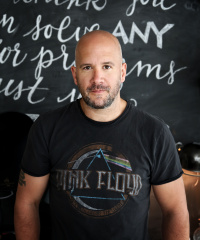How do you think public reaction is affecting brand design?
In the wake of recent rebrand U-turns, such as Everton and the University of California, how do you think public reaction is affecting brand design?

‘In a world of so much choice, brands are constantly fighting to get noticed. We are constantly having to develop new and exciting ways to ensure brands engage with their audience and gain brand loyalty. The public reaction to the University of California, Gap and more recently the negativity towards the new design for iOS7 (although I think most of the reaction was from the design community) at least means we are doing our jobs properly when it comes down to gaining brand loyalty! BUT… The general public are not brand experts and therefore take things at face value. They would just see the aesthetics rather than understanding the deep reasoning behind the decision for change – brand loyalists hate change. If a brand is 100 per cent sure that their new direction is the right one they need to try harder to get their brand loyalists onboard and educate them about their reason for change. There is a fine balance between keeping brand loyalty and ensuring a brand is constantly moving forward and thinking of the future.’
Emma Carter executive creative partner, Beyond Creative Thinking

‘A moment please for Everton’s designer. An own goal in front of a capacity crowd? Ouch. But this is graphic communication not life or death. Not even in football. Logos are notoriously subjective, passion-filled vials that can turn to poison turning the most design-averse spectator into articulate experts. And so the pain for you, the designer, is exquisite and public, but inevitably short-lived. Remember that even the most outrageous and contentious logos frequently become part of the mainstream vernacular and are occasionally adored. That is if the manager stands by you. After all, it’s his fault if he sent out a player who was less than match-fit.’
Emma Booty, creative director, Saffron

‘Ego and entitlement are the consistent ingredients of unintelligent design decisions; the greatest irony of designers and companies that intend to “modernise” or “make relevant” is that those involved tragically misunderstand that historical meaning and emotional resonances transcend the actual design. What is visible is in effect invisible; the significance eclipses the visual design. Many will argue that “people don’t like change”. While this is certainly true of many things, to use this argument to back up the molestation of symbols that are culturally synonymous with reassurance and respect is breathtakingly arrogant. And then of course, there’s just shit design.’
James Hilton, co-founder and chief creative officer AKQA





7 Principles of Desire.Very interesting article.
Worth having a look.
https://www.designweek.co.uk/industry-voice/how-to-make-people-desire-a-brand/3036663.article
Just imagine if the Olympics committee did a U-turn on the public outrage about Wolff Olins’ logo.
The games and everything that surrounded it, including the ceremonies turned out to embody the same spirit and attitude that the brand represented. It said “F*** you, this is London, this is the olympics, we’re gonna kick ass and be the best olympic games in history.”
The Olympic committee’s response should be used as an example of why, when the design is right, bowing to public backlash is overall damaging for the brand.
If both the Gap and UCLA brand refreshes were following a considered, strategic shift from within the organisation then the change was right.
It’s interesting that both recent major brand u-turns have been in America where the creative industries have a lot less backing from government bodies and established institution.
The brand managers may have felt a lot more isolated than those at major British organisations.
John Lowdon’s comment is spot on. I worked for LOCOG and after the backlash of the London 2012 logo we had to work hard to communicate the idea and story behind our brand. Yes, it took time (years) and we still had many non-believers, but we built a great deal of loyalty by great storytelling through our brand advocates.
I agree with with the above, but a creating a brand from scratch is different from a rebrand.
When rebranding it is vital to retain any positive brand loyalty and brand recognition that has been built up. That’s why other successful rebrands for major businesses have been an evolution, not a revolution. For example Starbuck’s siren in 2011.
As my old man would say, ‘If it ain’t broke, don’t fix it.’
Everything needs freshening up every so often, but the whole ethos of the brand as it stands must be considered first… Sadly this isn’t always the case. Take Man Utd who are to reinstall ‘Football Club” on their club crest… Why did they remove it in the first place?